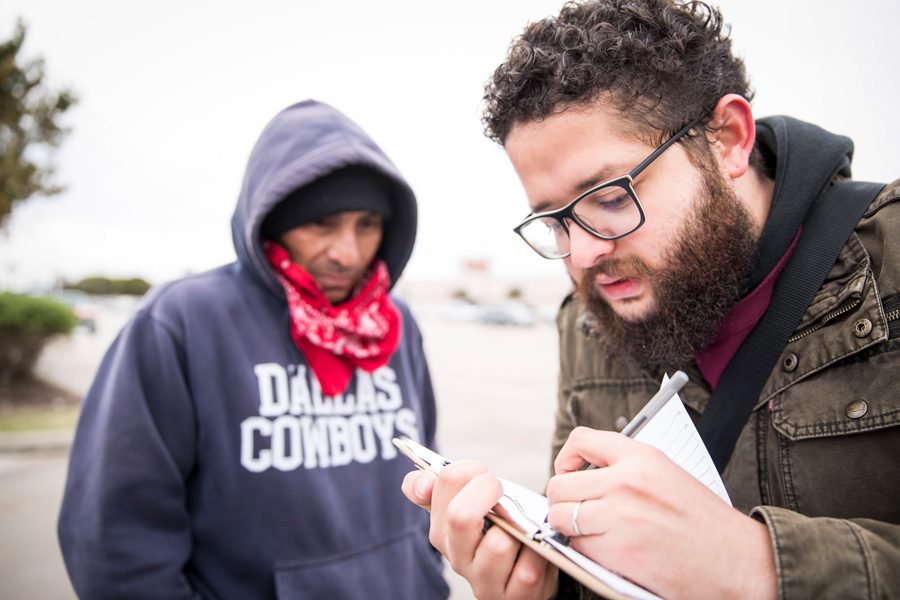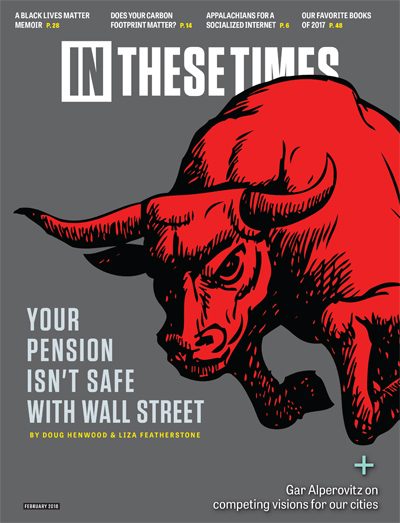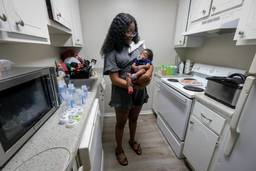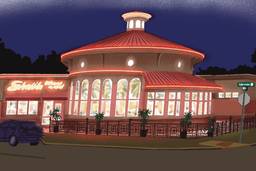Houston Is Being Rebuilt on a Foundation of Wage Theft
The exploitation after the storm.
Bryce Covert

To gird themselves against Houston’s freakish sub-40-degree weather, the jornaleros, or day laborers, draw the hoods of their sweatshirts so tight that just their noses peek out. Huddled in groups of four or five across a Home Depot parking lot, the clusters disintegrate when Maurico “Chele” Iglesias approaches.
Although Iglesias, an organizer with the Workers Defense Project, has been coming to this parking lot every other week for five months, he rarely sees a familiar face. “It’s always different people,” he says. “They always keep moving.”
The workers, primarily from El Salvador, Honduras and Mexico, now living in a state not known for its warmth toward immigrants, eye Iglesias with caution and edge away. His beard and dark glasses could easily be mistaken for a hipster aesthetic. But once he starts speaking in Spanish, his ease talking with day laborers quickly becomes apparent. A few circle back to hear what he has to say.
The jornaleros have become Houston’s go-to rebuilding corps in the wake of Hurricane Harvey. When the Category 4 hurricane made landfall Aug. 25, 2017, it destroyed an estimated 30,000−40,000 homes in the area and caused, by some estimates, nearly $200 billion in damage.
The work agreements these men enter into are loose at best. When a rental pickup pulls up, four men run over to it, knocking on the window. One gets in after an exchange of a few words, and the truck drives off.
On Dec. 8, 2017, Iglesias is here to gin up interest in an upcoming wage theft clinic and a two-day OSHA-certified training about health and safety protocols for gutting, cleaning and rebuilding damaged homes.
Wage theft and safety violations were rampant in Houston’s low-wage construction industry even before the storm hit, according to local worker centers. One study found that 12.4 percent of construction workers in the city suffered injuries on the job. “The Texas construction industry is … incredibly dangerous,” says José Garza, executive director of the Workers Defense Project. “For years, the industry has absolutely failed to prioritize safety.”
Harvey only exacerbated the problems, organizers say. Contractors came in from out of town, lured by FEMA money and work, and may not fear another state’s enforcement agencies. Small, independent contractors and individual homeowners may not know or follow the rules. Subcontractors are under pressure to reduce costs and may refuse to pay overtime or not pay until a job is finished — doling out nothing if a worker gets injured.
Construction work of any kind poses many safety risks: falls from roofs, injuries from heavy machinery or heavy lifting, eye damage from flying dust or fiber, ear damage from loud machines, lung damage from fumes or gases. But hurricane recovery brings its own particular dangers.
Mold grows rampant in flooded homes and can cause serious respiratory problems without proper training and equipment. Older houses may have lead and asbestos in the walls. And storm waters don’t just bring flood damage: They also contain sewage and sometimes chemicals from nearby factories. “All the contamination that came [in with storm water] stays in the drywall, stays in the carpet, and people are taking all of that out and carrying that and getting sick,” says Marianela Acuña Arreaza, executive director of the Houston-based Fe y Justicia Worker Center. In October 2017, Josue Zurita, who had been repairing homes damaged by Harvey, died of a flesh-eating bacterial infection likely picked up on a job site.
In the Home Depot Lot, the stories of exploitation flow quickly. After first denying that there are any health or safety hazards, two jornaleros acknowledge that not all contractors provide required gloves or safety glasses. Many of them sport sneakers rather than the work shoes or boots mandated by OSHA for construction.
Francisco, a younger man with a spiky mustache, pulls out an arm he had kept tucked inside a sweatshirt for warmth to display a swollen set of stitches just below his wrist. He had an accident with a machine at a worksite that required a trip to the hospital. He received no workers’ compensation for his injuries — and no pay for the hours he worked that day.
José, whose lightweight boots are splattered with paint and dust, says he was cheated out of pay for 20 hours spent removing sheetrock at a post-Harvey site. An older man with a patchy beard, also named José, tells a story about a worker who was driven to a job site far away and left stranded there without being paid. When he tracked down the man who hired him, he was shot in the arm and stomach. He survived — and is still showing up looking for work.
In November 2017, the Fe y Justicia Worker Center and the National Day Laborer Organizing Network released a survey of 361 day laborers. It found that more than a quarter had been victims of wage theft in the aftermath of the hurricane — about half the number of incidents over the past year happened in the first four weeks after the storm — with the total wages they were collectively owed exceeding $20,000.
Eighty-five percent of the day laborers surveyed said they hadn’t received any health and safety training at their worksites, and more than a third reported having been injured. Thirty-two percent are doing the work without the proper gloves, 40 percent without protective glasses, 41 percent without steel-toed boots, 61 percent without a respirator and 64 percent without a hard hat.
“Workers are fixing up … homes or apartments without the proper breathing equipment,” Iglesias says. “Some of them get sick the first night: fever, itchy throat, bloodshot eyes.”
Martin Mares, a compact man with lined, sunken eyes and heavily worn cowboy boots, says he and his wife decided to find work on Facebook after the storm hit. A veteran Houston construction worker, he found an ad promising $120 a day, seven days a week. At one work site, the workers had to share gloves, overalls and glasses. The masks they were given only protected against dust, not mold. And the gloves were made out of cloth and only useful for removing garbage, not carpet or sheetrock. Yet workers only got one pair to last the entire day. He even witnessed pregnant women using toxic chemicals without protection.
“Although they said they had experience and it was a big company … the people managing the projects didn’t have enough experience to handle 100 people,” he says.
When he went to pick up his pay, he says, it took four hours of negotiation, and even then he was shorted $10 a day. “I don’t believe that a business of this size doesn’t have money to pay,” he says. “It’s part of a system of fraud.”
Iglesias believes things are only getting worse as the recovery continues. At a mid-November wage theft clinic he held, eight workers showed up who hadn’t been paid anything at all for Harvey-related work. He also received a complaint about a large, commercial construction site where workers were putting in 60 hours a week but not getting overtime.
“[Contractors] claim that because we were in a state of emergency due to Harvey, they are not required to give overtime, and that is a plain lie,” he says. “Harvey is being used as a reason for more abuses.”
When President Trump visited Texas in the wake of Harvey, he basked in applause and boasted about the recovery efforts. “You have been just outstanding,” he told local officials. “We won’t say congratulations … We’ll congratulate each other when it’s all finished, but you have been terrific.”
Officials similarly patted themselves on the back in the wake of Hurricane Sandy, which hit New York and the East Coast in 2012. “Nobody’s ever responded this way to a disaster. [We have] actually fixed things,” Mayor Michael Bloomberg said of his administration’s efforts. “We haven’t just had press releases, we’ve actually done an enormous amount.” He claimed the effort was so impressive someone would write a book about it.
Yet what these politicians are praising, usually, is the work of unsung day laborers. In the wake of Sandy, workers came from as far as Georgia to rebuild New York. The worker center Make the Road New York was a first line of defense against exploitation.
“The situation after the storm for workers, in particular undocumented workers, was pretty bleak,” says Sara Cullinane, then a staff attorney at Make the Road New York and now director of Make the Road New Jersey. Workers had stories similar to those of the Houston jornaleros: driven to faraway sites, given no protective equipment, and shorted on wages.
In Houston, Fe y Justicia was the only worker center in the city for 11 years before Workers Defense Project set up shop in 2017. It’s currently at capacity for wage theft cases. At Arreaza’s last count, the organization was getting about 20 calls a day, 10 of them regarding new claims. “It’s crazy, it’s unbelievable,” she says. “It’s really intense.”
If a worker brings a complaint, the organizations have a variety of tactics at their disposal: Bring direct litigation themselves, send the complaint to a state agency or, if the case seems difficult to prosecute, organize direct action. “Sometimes the best thing to do is to show up with 20 people outside their house and demand payment,” Garza says.
Since Harvey, Fe y Justicia has also trained about 200 people in how to use protective equipment, what symptoms of exposure look like, and how to protect people from hazards like mold. Iglesias estimates he has spoken with hundreds of workers and tried to educate them as part of his outreach.
It isn’t only up to workers’ centers to protect workers, of course. Wage theft is illegal and the purview of the federal Department of Labor, as well as the Texas Workforce Commission. State and federal OSHA officials are tasked with ensuring workplaces are safe. But they can be slow to respond. “I don’t think we have heard a ton from them,” Garza says. “We haven’t seen the kind of leadership [at OSHA and the DOL] that demonstrates that they are making Houston a priority.”
According to a 2015 investigation by ABC13, the city’s OSHA offices, like many around the country, are extremely understaffed, with only two dozen inspectors to cover the city’s job sites, including its oil refineries and booming construction industry. Houston’s OSHA offices conducted more than 1,000 safety briefings as part of their Harvey response, but were not able to say whether they had inspected any hurricane-affected sites.
Neither the Department of Labor, the Texas OSHA office nor the Texas Workforce Commission responded to requests for information about wage theft enforcement after Harvey.
Ultimately, organizers say, the goal is to empower workers themselves. “We want workers to organize, to know their rights, to make sure that they claim their rights and … inform other workers about their rights as well,” Iglesias says.
“Los derechos laborales son universales,” he tells the workers at the Home Depot lot: Labor rights are universal. He gives them tips to help hold contractors accountable, like taking photos of license plates and dropping pins in Google Maps at construction sites.
Worker empowerment can also be harnessed to push for longer-term changes. “The real important process … is helping working people to have agency and to build power,” Garza says. “And then converting that power into meaningful policy change that ensures we don’t have to face this situation every time a hurricane rolls through town.” His organization has been in talks with local leaders about passing legislation, such as a living wage and workers’ comp for construction workers, although he said everything is still preliminary. “It is not the moon that we are asking for,” he says. “It is basic standards.”
In fact, plenty of other places have instituted government contracting policies that encourage developers to pay well and cover employees with workers compensation: According to research by the Illinois Economic Policy Institute, at least 224 cities and counties in the U.S. had adopted such policies as of 2015.
Asking day laborers to push for change can be difficult. Martin Mares notes that many workers he knows don’t bother to fight for the pay they’re owed. Some don’t want to waste hours that could be spent doing more work or resting. For others, dealing with courts and judges is far too risky given fears over immigration enforcement. Others simply accept the conditions they work in.
“But that’s not the point,” Mares says. “The point is to show that there are laws that protect us … and show that the power that workers have is bigger than the dollar.”
Bryce Covert is an independent journalist writing about the economy. She is a contributing writer at The Nation, and her writing has appeared in the New York Times, New York Magazine, Bloomberg Businessweek, The Atlantic, Time Magazine, Wired, the New Republic and others. She is a 2025 National Fellow at the USC Annenberg Center for Health Journalism and a 2025 recipient of the McGraw Fellowship for Business Journalism, and she was a Reporter in Residence at the Omidyar Network in 2023.








